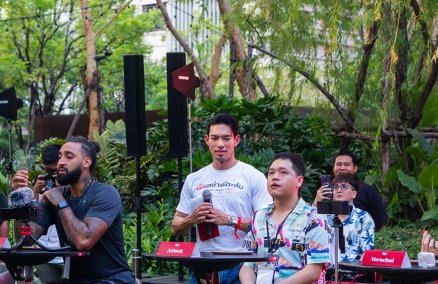Even without the recent controversy—where the National Arts Council withdrew its $8,000 grant saying it "undermines the authority of the Government"—Sonny Liew’s 360-page graphic novel The Art of Charlie Chan Hock Chye is an important book. Involving a fictitious comic book artist, it creates an imagined history of Singaporean comics against the very real history of Singapore. Here, the Malaysian-born artist tells us how the book expanded to three times its original size and whether art should be constrained by politics.
It turned out to be the best possible thing for the book. We were worried about finances at first, because the publisher had already spent the money. But given the reaction that we’ve gotten, that’s maybe less of a concern now.
The wider issue is whether the NAC should be an organization that looks at art as art—based on its merit—or whether it should be constrained by political concerns.
I worry schools might be less willing to take it up because of the controversy. I would love for students to read it, for it to be a part of a classroom or extracurricular discussion.
The government still sees the arts as a community-building thing. A lot of money still goes into traditional arts, traditional dance, SSO and stuff like that. It’s important to support those, but you shouldn’t see art as just a means to that one end.
My main motivation for becoming a Singapore citizen was to be more involved in things here. At the last elections, my friends volunteered at ballot counters, and that’s something you can only do as a Singaporean.
When I started thinking about this book, I was conscious of the fact that the government has always said that you have to be a stakeholder to be comment about politics here.
I remember there was an SQ pilot who was Malaysian who got involved in union politics and had his PR revoked. I don’t know how realistic my fears of a similar fate were. There are all these concerns and fears that might not be real, but they’re internalized in the people here.
Singapore feels like home. I’ve been here since I was in kindergarten. My parents sent me and my sister here when we were really young. I feel quite Singaporean, even though I didn’t do NS and I used to travel back and forth during holidays.
When I was young, Malaysia and Singapore didn’t feel that far apart. I remember the days when the ringgit and the Singapore dollar were one for one.
I started working on the book in 2012, so it’s been three years. The first two years were a lot of research, reading, interviews and doing the thumbnails in between other projects.
First, I was going to create a whole generation of comic book artists, a comprehensive history of Singapore comics. I thought of that five or six years ago and tried to explain it to friends. It was a tricky concept to explain with just words, most of them had no idea what I was talking about. At the time it didn’t seem to be the kind of book for which you could find a publisher. Local ones didn’t pay any money at all. And it didn’t seem like US publishers would be interested in this sort of thing. So I put it on the backburner for a while until Epigram approached a bunch of us to do local comics.
It was supposed to be 120 pages when it was first conceived. We were supposed to produce it in six months. I thought I would do 120 pages with a lot of essays and drawings and squeeze it out in time. But when I started doing it, it took a life of its own. I realized it needed take a different form.
It was easier fabricating a comic book lineage because of the vacuum in Singapore. If there was a rich history of comics and you created a fake person, you’d have problems connecting him to the real world—what would his connections be to real artists, publishers or critics? In Japan or US, if you tried something like this, you’d have a much harder time.
The local comic scene has improved. All creative industries have grown because we have a more mature economy now. Back in the 60s everyone was being pushed to do engineering, manufacturing and other industries that were more practical. Nowadays the economy can sustain creative careers—perhaps advertising, design and illustration more so than comic books. For comics you still have to break into overseas markets to make a proper living.
Superhero comics are more of a technical challenge: people flying about, superpowers on display, all that special effects stuff. It’s a bit tricky to handle technically. You’re not so much involved in the story process because that’s the writer’s job. It definitely pays better than indie comics.
I read a lot of Calvin and Hobbes in my teens. Earlier on, there was 2000 AD, the British comic featuring Judge Dredd. Of course I read Tintin, Asterix, Archie, Mad Magazine, Lao Fu Zhi and all that growing up too.
The shift from conventional to indie comics happened when I discovered the Canadian artist Chester Brown—his comics were one of the first to open my mind to a different kind of approach to the medium.
I’m distracted by Facebook a lot because after the NAC saga, I get a lot of friend requests and lots of updates and notifications I didn’t have before. You feel a responsibility to respond and that takes time. I suppose it’s a good problem to have, and it’ll die down soon enough.
Every time you publish something, you feel a sense of success. When my comics first appeared in The New Paper, I felt on top of the world. But that feeling fades pretty quickly. You realize there’s always another step to climb. As an artist, you want to get better—in terms of drawing, storytelling, financial planning.
There’s some fear whether I’ll have another idea as interesting as this one, or whether I’ll be repeating the same formal methods I’ve used in this book.
I have a couple of books in mind I’d like to do next. One of them involves meshing together an adventure story with an examination of capitalism in the 21st century, the power structures and how we fit as individuals in this global machine.
I try to find time for friends and family. As an artist, you tend to neglect the social part of life. I read that when Bill Waterson was working on Calvin and Hobbes, he would turn down almost every dinner engagement because he was drawing all the time. That was partly why he retired early, to have a proper life.















